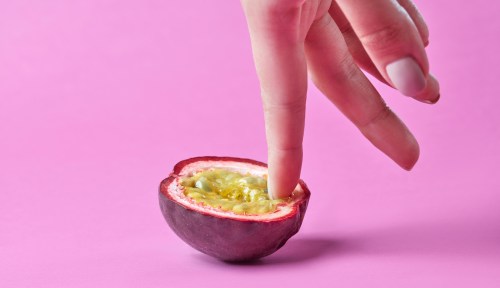Our editors independently select these products. Making a purchase through our links may earn Well+Good a commission
Your A-to-O Glossary for 14 Different Types of Orgasms—and How To Achieve Each
Learn the 14 most common types of orgasm, from clitoral to g-spot to anal to blended and how to have them.

As the old adage goes, orgasms are like snowflakes: every one unique and worthy of awe in its own way. Okay, okay—maybe people don’t say that, but they should. Because as far as pithy ways of categorizing different types of orgasms, you could do worse; orgasms are all worthy of the kind of slack-jawed awe we usually only reserve for the miracle of nature (in more ways than one). Types of orgasms can vary greatly, in intensity, duration, and even the number of orgasms you might have at once.
Experts in This Article
entrepreneur, sex expert, and the CEO of sex-education platform O.school.
staff sexologist and educator at Good Vibrations
professor and director of the Center for Sexual Health Promotion at Indiana University, in Bloomington, Indiana
sexologist and host of the podcast Sex With Dr. Jess
sex educator and owner of Early to Bed
New York City-based sex researcher, writer, and educator
“Any type of orgasm across the body can be powerful, pleasurable, and worth exploring,” explains sexologist Jess O’Reilly, PhD. While you should indeed feel free to explore the myriad of different types of orgasms that exist, don’t put too much pressure on yourself to have every kind imaginable. They’re orgasms, not trading cards: you definitely do not need to stress out about collecting each kind. Instead, Dr. O’Reilly recommends following your pleasure and seeing where it takes you. What an orgasm feels like will differ for each person and situation, so take your time prioritizing what feels good to you.
“Any type of orgasm across the body can be powerful, pleasurable, and worth exploring.”— Jess O’Reilly, PhD, sexologist
And while all orgasms are different, it might help to categorize them into common subcategories, also like snowflakes. To help you do that, we’ve tapped sexperts to break down 14 of the most common types of orgasms, with tips on how to explore each kind.
Here are 14 common types of orgasms:
1. Convulsing orgasm
A convulsing orgasm usually involves significant build-up that results in powerful muscle contractions that look and feel convulsive, sexologist Carol Queen, PhD, explains. “In a way, this is a more extreme version of the ‘toe-curling orgasm’” Queen explains, as the convulsing orgasm is a bigger build-up and a whole-body response.
For the best chances of having a convulsing orgasm, you may want to try edging or otherwise drawing out your pleasure and erotic experience for a long time. Doing so, can help “build up toward higher levels of arousal and extend the body’s responses,” Queen explains, which may result in the kind of stronger orgasm response needed for a convulsing orgasm.
2. Energy orgasm
As far as types of orgasms go, this one is more abstract. An energy orgasm is usually associated with Tantra and non-genital (or even bodily) contact, Dr. Queen explains. It might sound similar to sex without orgasming, but the ~energy~ here is what makes this type of orgasm different. While orgasm is usually associated with localized genital or bodily stimulation (think clitoral orgasm or breast orgasm), it actually happens in the brain where it’s potentially triggered by many different kinds of stimulation and high arousal states, Dr. Queen says.
This might help to explain how one can have an orgasm without touching at all. “These [orgasms] include eye contact (or eye-gazing) and breathing in specific patterns, often while in contact with a partner,” Dr. Queen says, adding that this heavy eye-contact and rhythmic breathing is “where we get the notion of ‘exchanging energy.’”
3. Sleep orgasm
A sleep orgasm is basically when you’re in REM sleep and climax while deep in a dream, Dr. Queen explains. You may have also heard sleep orgasms referred to as “wet dreams” for people who can ejaculate.
Fun fact: sleep orgasms can be considered one of the OGs, as famous sex researcher Alfred Kinsey noted sleep orgasms in his research for Sexual Behavior in the Human Male and Sexual Behavior in the Human Female, Dr. Queen adds.
4. Erogenous zone orgasm
An erogenous zone orgasm “acknowledges that all orgasms don’t come from direct genital or pleasure part stimulation,” Dr. Queen says. And note: the inclusion of the term “pleasure part” encompasses parts of the human anatomy like the anus, which isn’t part of the genitals, but can still be a source of pleasure for many, she adds.
These erogenous zones can include body parts like the lips, mouth, ears, neck, wrists, elbows, knees, lower back, feet and toes, nipples… and of course, the largest organ: the skin. “Stimulation of all these parts (or even just one of them) can potentially result in orgasm,” Dr. Queen explains. If you want to get creative with it, experiment with these e-zones through massage, licking, kissing—basically, follow your pleasure.
5. Anal orgasm
“Some folks can experience orgasm from touch that is not directly on the vulva or in the vagina, and some people can have an orgasm from anal stimulation or penetration alone,” says sex educator Searah Deysach, owner of sex toy shop Early to Bed. Anal orgasms can occur through external licking, kissing, or touching, deep massage or penetration. For penis-havers, anal orgasms can also result in prostate orgasm.
6. Blended orgasm
Blended orgasms refer to intensifying an orgasm by stimulating two or more pleasure zones at once. “Some people describe their blended orgasms as feeling more intense, deeper, or just as more because there are multiple points of stimulation,” sex expert Andrea Barrica, CEO of sex-education platform O.school, previously told Well+Good.
A good way of exploring blended orgasm techniques is by pairing clitoral stimulation with vaginal penetration. This can be done with a partner and some manual techniques, or a dual-stimulation rabbit vibrator, if you’re playing alone. Just like with your smoothie ingredients, feel free to experiment to keep things interesting.
7. Breast orgasm
Your breasts can also be a highly potent erogenous zone and stimulation can lead to a breast orgasm. “This may be attributable to the fact that the genital sensory cortex, which is the same region impacted by stimulation of the vagina and clitoris, is activated through nipple play,” Dr. O’Reilly previously told Well+Good. “Scientists hypothesize that these shared neurons release oxytocin, which induces pleasure and relaxation, and spikes to peak levels just before orgasm.”
While a breast orgasm can result from direct stimulation of the breasts, others can experience it as an extension of another orgasm, Dr. O’Reilly explains. “For example, you play with the breasts to warm them up and awaken the nerve endings, but then you reach orgasm through another means of stimulation—e.g., vibrating against your clitoris or oral sex—and you feel the sensations intensely in the breasts, due to the previous stimulation.”
8. Cervical orgasm
This is an orgasm that can happen by stimulating the cervix, which is located deep within the vagina. It’s the ring of tissue separating the uterus from the vagina, usually requiring long and slightly curved penetration inside the vagina to reach. Heads up—you don’t want to voyage to this pleasure center unless you’re fully turned on. Dr. Queen also notes that if you feel discomfort or pain with cervical pressure or deep thrusting, you may want to skip this altogether, as it could be painful.
“The sensitive cervix is believed to relay messages to the brain via the hypogastric nerve1, and many people report that direct stimulation is only pleasurable once they’ve reached higher levels of arousal, and the palliative chemicals have flooded the body,” Dr. O’Reilly previously told Well+Good.
9. Coregasm
Coregasms are orgasms that occur when you’re exercising, according to sexual health expert Debby Herbenick, PhD, director at the Center for Sexual Health Promotion at Indiana University and author of The Coregasm Workout. The caveat here is that it’s pretty uncommon to experience: One survey suggests about 10 percent of people have experienced a coregasm in their life. However, if you’re looking to experiment, Dr. Herbernick suggests focusing on exercises that are “core-demanding, that ask a lot of core abdominal musculature,” as she previously told Well+Good. “People who have [coregasms] from crunches often say it takes 100 or 200 crunches before it happens.”
10. Clitoral orgasm
For many, an external clitoral orgasm is the fastest way for vulva-owners to reach climax. “This is because the external clitoris is the part of the body that contains the greatest density of nerve endings that, when stimulated, can lead to pleasure,” human sexuality professor Zhana Vrangalova, PhD, previously told Well+Good. For the majority of vulva-owners, clitoral stimulation orgasm may be the easiest way to orgasm during sex, as research shows that less than 20 percent of vulva-owners orgasm2 from penetration alone.
11. Disappearing orgasm
A disappearing orgasm can also sometimes be called a “half orgasm” or “ruined orgasm,” and refers to getting close to climax but ultimately, not climaxing.”You’ll get close to an orgasm, but then just kind of lose it,” says Deysach. “You feel the tension and build up, and just when you think you might fly over the cliff, the feeling fades.” These can be accidental (thanks to distraction, interruption, or other change in stimulation) or done on purpose, like part of BDSM play, Dr. O’Reilly explains.
12. G-spot orgasm
The G-spot can be found along the top wall of the vagina. “For some folks—but not all—putting direct pressure on that spot can result in orgasms,” says Deysach. “Usually, this happens when combined with other stimulation, like external clitoral or nipple stimulation arousal, but sometimes, orgasm is reached from just from the pressure applied internally.”
13. Squirting orgasm
A squirting orgasm refers to when a vagina-haver releases fluid mid-orgasm, similar to how penis-havers typically ejaculate when they orgasm. “Not all vagina-havers achieve this, but putting pressure on the G-spot can help many people do so,” says Deysach.
If you’d like to try to have a squirting orgasm, the experts recommend using a curved toy (or a finger curved inward within the vagina), and pulling up toward the wall of your stomach. This is one of the most direct pathways to the G-spot stimulation that can sometimes result in a squirting orgasm. Dr. O’Reilly suggests pressing down gently on the outside of your stomach at the same time, and if you feel as though your muscles are inclined to bear down, exaggerate the feeling and release your pelvic floor.
And while squirting orgasms can be fun, the act of squirting may not mean a more intense orgasm in and of itself, she adds.
14. Multiple orgasms
“This is when you have a series of orgasms in a row without much—if any—of a refractory period in between,” says Deysach. “It could be two in a row, or it could be 20.” In certain cases, continued stimulation after a clitoral orgasm is the only thing necessary to bring on the chain reaction. (But for some, any extra stimulation post-orgasm is uncomfortable or unpleasant due to hyper-sensitivity of the clitoris—so, remember to listen to your body.)
Multiple orgasms can take on a variety of forms, according to Dr. O’Reilly, adding that “some people have a series of less intense orgasms followed by a big-bang moment, while others alternate between different kinds of stimulation to experience different types of sensations as they orgasm.”
To up your chances of experiencing multiples, try exaggerating your inhales and exhales through deep breathing while you’re building up to your first orgasm, Dr. O’Reilly recommends. “When your arousal levels peak and your body wants to take quick, shallow breaths, defy its natural inclination and continue to breathe slowly, inhaling through your nose and exhaling through your mouth,” she adds.
With reporting by Erica Sloan.
Courtois, Frédérique, and Kathleen Charvier. “Sexual dysfunction in patients with spinal cord lesions.” Handbook of clinical neurology 130 (2015): 225-245.
↩︎Herbenick, Debby, et al. “Women’s experiences with genital touching, sexual pleasure, and orgasm: results from a US probability sample of women ages 18 to 94.” Journal of sex & marital therapy 44.2 (2018): 201-212.
↩︎
Sign Up for Our Daily Newsletter
Get all the latest in wellness, trends, food, fitness, beauty, and more delivered right to your inbox.
Got it, you've been added to our email list.










